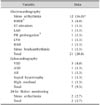1. Driscoll DJ, Glicklich LB, Gallen WJ. Chest pain in children: a prospective study. Pediatrics. 1976; 57:648–651.

2. Fyfe DA, Moodie DS. Chest pain in pediatric patients presenting to a cardiac clinic. Clin Pediatr (Phila). 1984; 23:321–324.

3. Pantell RH, Goodman BW Jr. Adolescent chest pain: a prospective study. Pediatrics. 1983; 71:881–887.

4. Bernstein D. History and physical examination. In : Kliegman RM, Stanton BF, St Geme JW, Schor NF, editors. Nelson textbook of pediatrics. 20th ed. Philadelphia: Elsevier Saunders;2015. p. 2163–2170.
5. Yoon KL. Chest pain in children and adolescents. J Korean Med Assoc. 2010; 53:407–414.

6. Sabri MR, Ghavanini AA, Haghighat M, Imanieh MH. Chest pain in children and adolescents: epigastric tenderness as a guide to reduce unnecessary work-up. Pediatr Cardiol. 2003; 24:3–5.

7. Jang KM, Choe BH, Choe JY, Hong SJ, Park HJ, Chu MA, et al. Changing prevalence of helicobacter pylori infections in korean children with recurrent abdominal pain. Pediatr Gastroenterol Hepatol Nutr. 2015; 18:10–16.

8. Asnes RS, Santulli R, Bemporad JR. Psychogenic chest pain in children. Clin Pediatr (Phila). 1981; 20:788–791.

9. Raiola G, Galati MC, De Sanctis V, Salerno D, Arcuri VM, Mussari A. Chest pain in adolescents. Minerva Pediatr. 2002; 54:623–630.
10. Selbst SM. Chest pain in children. Pediatrics. 1985; 75:1068–1070.

11. Swenson JM, Fischer DR, Miller SA, Boyle GJ, Ettedgui JA, Beerman LB. Are chest radiographs and electrocardiograms still valuable in evaluating new pediatric patients with heart murmurs or chest pain? Pediatrics. 1997; 99:1–3.

12. Kim JH, Moon HK, Jun JG. Clinical study of chest pain in children. J Korean Pediatr Soc. 1990; 33:1526–1532.
13. Leung AK, Robson WL, Cho H. Chest pain in children. Can Fam Physician. 1996; 42:1156–1160. 1163–1164.
14. Selbst SM. Consultation with the specialist. Chest pain in children. Pediatr Rev. 1997; 18:169–173.

15. Evangelista JA, Parsons M, Renneburg AK. Chest pain in children: diagnosis through history and physical examination. J Pediatr Health Care. 2000; 14:3–8.

16. Selbst SM, Ruddy RM, Clark BJ, Henretig FM, Santulli T Jr. Pediatric chest pain: a prospective study. Pediatrics. 1988; 82:319–323.

17. Rowe BH, Dulberg CS, Peterson RG, Vlad P, Li MM. Characteristics of children presenting with chest pain to a pediatric emergency department. CMAJ. 1990; 143:388–394.
18. Kocis KC. Chest pain in pediatrics. Pediatr Clin North Am. 1999; 46:189–203.

19. Woolf PK, Gewitz MH, Berezin S, Medow MS, Stewart JM, Fish BG, et al. Noncardiac chest pain in adolescents and children with mitral valve prolapse. J Adolesc Health. 1991; 12:247–250.

20. Berezin S, Medow MS, Glassman MS, Newman LJ. Esophageal chest pain in children with asthma. J Pediatr Gastroenterol Nutr. 1991; 12:52–55.

21. Hsia PC, Maher KA, Lewis JH, Cattau EL Jr, Fleischer DE, Benjamin SB. Utility of upper endoscopy in the evaluation of noncardiac chest pain. Gastrointest Endosc. 1991; 37:22–26.

22. Berezin S, Medow MS, Glassman MS, Newman LJ. Chest pain of gastrointestinal origin. Arch Dis Child. 1988; 63:1457–1460.

23. Katz PO. Approach to the patient with unexplained chest pain. Semin Gastrointest Dis. 2001; 12:38–45.

24. Lipsitz JD, Masia C, Apfel H, Marans Z, Gur M, Dent H, et al. Noncardiac chest pain and psychopathology in children and adolescents. J Psychosom Res. 2005; 59:185–188.

25. Shin SA, Kim YJ, Lee JW, Kim NS, Moon SJ. Clinical evaluation and diagnosis of children with chest pain. J Korean Pediatr Soc. 2003; 46:1248–1252.
26. Cheung TK, Lim PW, Wong BC. Noncardiac chest pain--an Asia-Pacific survey on the views of primary care physicians. Dig Dis Sci. 2007; 52:3043–3048.








 PDF
PDF ePub
ePub Citation
Citation Print
Print






 XML Download
XML Download